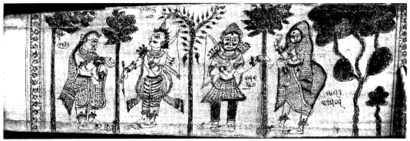Adhyatma Ramayana

Adhyatma Ramayana (Devanāgarī: अध्यात्म रामायण, literally "Spiritual Ramayana") is an ancient Sanskrit work extolling the spiritual virtues of the story of Ramayana. It comprises around 4200 double verses embedded in the latter portion of Brahmānda Purana and is traditionally believed to be authored by Vyasa. Taking the form of a dialogue between Shiva and Parvati, it contains the ideal characteristics of Lord Rama and the precepts related to devotion, knowledge, dispassion, adoration and good conduct. It is also considered a treatise of Vedantic philosophy. It is supposed to have inspired several later versions of the Ramayana story in languages like Awadhi (Ramcharitmanas by Tulsidas), Oriya, Bengali and Malayalam.
Significance
Adhyatma Ramayana represents the story of Rama in a spiritual context. In this version everything is preordained, and Rama being the Brahman himself, doesn't kill or destroy, but rather offers salvation to those he kills. Thus this act is called Uddhar.

It also provides several valuable insights into the various seeming anomalies in the popular versions of the Ramayana, like:
The provocation of the Queen Kaikeyi by her maid Manthara, was not an evil act of her choice as presented in Valmiki's version of the Ramayana, but mastered by the Goddess of Knowledge, Saraswati, thus Manthara appears only to be playing her character in the larger drama of destiny, which leads to the killing of Ravana, the sole reason Lord Vishnu incarnated as Rama.
Similarly, according to this text, the real Sita was never really abducted by Ravana. Rama, being the all-knower in this version, has a premonition about the abduction, and thus instructs Sita to invoke Agni, the God of Fire, and creates an illusory self, or Maya Sita. Thus, when Ravana finally appears, Sita plays along, and the illusory Sita is abducted, and is regained after the fire ordeal, once Ravana is killed.
It makes us aware of the larger-than-life aspects of Lord Ram, and the fact that he, being the Brahman (Supreme Creator) incarnate, acts to instruct. Adhyatma Ramayana raises every mundane activity of Rama to a spiritual or transcendent level, thus instructing the seeker to view his or her own life through the symbolic vision for his soul, where the external life is but a metaphor for the eternal journey of the soul.
The book is aimed to be used as a guide and a ready source of instruction for a spiritual seeker, as it presents the Ramayana as a divine allegory, where an exiled king, a man out of his element, gets beguiled by the lure of maya or the illusions, maya mrigya, and hence loses his Beloved (Sita), to the demon or dark forces (Ravana). Later when he repents and asks for divine grace, he is given the strength and friends (Hanuman) to help him reclaim his divinity (his Beloved).
Overview
| Part of a series on |
| Hindu scriptures |
|---|
 |
|
|
Timeline |
The Adhyatma Ramayana is organized into seven Kandas, or chapters:
1. Bal Kand - This chapter begins with the description of Brahmaswarup, the cosmic and celestial appearance of Lord Rama as an avatar of Vishnu, who descended to earth as a human being to remove rakshasas(demons) such as Ravana. It includes Rama’s childhood and the story of Ahilya's deliverance by Rama.
2. Ayodhya Kand - Life in Ayodhya, including Rama's exile, the death of his father Dasarath, etc.
3. Aranya Kand - The forest (Aranya) chapter, which includes the kidnapping of Sita by Ravana.
4. Kishkindha Kand - the episode of Kishkindha. This chapter describes the killing of Bali, and the initiation of the active search for Sita.
5. Sundar Kand - details Hanuman's arrival and activities in Lanka.
6. Lanka Kand - corresponding to the Yuddha Kanda of the Valmiki Ramayana. It contains details of the battles between Rama's armies and Ravana, the killing of Ravana, and the coronation of Rama upon his return to Ayodhya from Lanka.
7. Uttar Kand - Epilogue. It includes the banishment of Sita, the birth of Lava and Kusha - the sons of Rama and Sita - and Rama’s departure from the earth to Vaikuntha, the abode of Lord Vishnu. The fifth adhyaya (sub-chapter) of the Uttar Kanda describes a conversation between Lord Rama and his brother Lakshmana, often referred to as the Rama Gita (the song of Rama). It is essentially an Advaitic philosophical work.[1]
Translations
- Swami Tapasyananda, Adhyatma Ramayana, Original Sanskrit, with English Translation, Sri Ramakrishna Math, Madras. 1985.
- Baij Nath Puri, Lala Baij Nath. The Adhyatma Ramayana, Cosmo Publications, 2005. ISBN 81-7755-895-1.
- Beladakere Suryanarayana Shastri, Adhyatma Ramayana, Kannada translation with Sanskrit original, Shri Jayachamaraja Granthamala, Series 47, Mysore, 1948.
Munipalle Seshagiri Subrahmanya Kavi[? 1550-1600 ],[2] Rajaguru in the court of Daamera Krishna Bhoopala [Sri Kalahasti ] translated into Telugu language omitting uttarakanda. He wrote 104 keertanas [of which 6 were in Sanskrit ] using 58 ragas.
See also
- Adhyathmaramayanam
- Ramayana
- Ramcharitmanas by Tulsidas
References
- ↑ Adhyatma Ramayana advaita-vedanta.org
- ↑ ←
- Puri, Baij Nath. The Adhyatma Ramayana, Cosmo Publications, 2005. ISBN 81-7755-895-1.
- Williams, Joanna. The Two-Headed Deer: Illustrations of the Ramayana in Orissa. Berkeley: University of California Press, c1996.
- Richman, Paula, editor. Many Ramayanas: The Diversity of a Narrative Tradition in South Asia. Berkeley: University of California Press, c1991.
- Bagchi, P. C., Introduction to Adhyatmaramayanam, Page 76.
- F. Whaling, The Rise of the Religious Significance of Rama, Page 113.
- J. L. Brockington, Righteous Rama: The Evolution of an Epic, Page 252-57.
' Ramayana kathaganam- adyatma ramayana visishtata ' by M.S.Rani Prameela Devi
'saraswata vyasamulu ' by Nori Narasimha sastri